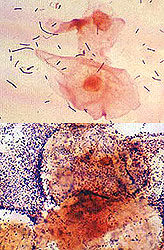Gardnerella, causing vaginal dysbacteriosis, are not pathogenic microorganism in its pure form, since in small quantities there are also in a normal vaginal microflora. Scientists still argue about whether the garardnellosis can be considered a venereal disease or not.
Content
 Gardnellosis is one of the most common infectious diseases of the genital organs in women of reproductive age - is a vaginal dysbiosis associated with quantitative and qualitative violations of the vaginal environment. Another name of this disease is bacterial vaginosis.
Gardnellosis is one of the most common infectious diseases of the genital organs in women of reproductive age - is a vaginal dysbiosis associated with quantitative and qualitative violations of the vaginal environment. Another name of this disease is bacterial vaginosis.
The causative agent of Gardnernellis is a microorganism that is called Gardnerella (Gardnerella Vaginalis). Some researchers even believe that Gardnernel's herself is not the causative agent of Gardnerellize, it takes only indirect participation in the development of an infectious disease, as it creates favorable conditions for the vital activity of other microorganisms and anaerobic (i.e. living in an oxygen-free) bacteria.
It is caused by the fact that Gardnernellas actively multiply in the microflora of the vagina and the urethra, while their livelihoods quickly destroy the normal microflora of the urinary tract and contribute to the development of inflammatory processes in which other, really high-pathogenic, microorganisms can participate.
From above, we can conclude that the gardnerellosis is due to an imbalance of the vaginal microflora. Most often, Gardnerless is infected with sexually active women who ignore barrier methods of contraception even when changing the partner. The emergence of a new sexual partner, even healthy, can cause vaginal dysbiosis, because the vagina's microorganisms are not immediately adapted to «Choons» Microbes of her partner.
In addition to the recent transfer of the sexual partner, there are other risk factors for the development of Gardnerellize, which a woman should know about. Violation of normal microflora vagina, i.e. dysbacteriosis (gardnelase) occurs when using some vaginal tablets and a wide range of action (TERJIN, POLYZINAX, BETADIN), when using local contraceptives, when driving, when taking a wide range of action antibiotics.
All these actions may have similar consequences: the normal vaginal microflora is suppressed, which means it increases the proportion of Gardnerell, mycoplasm and anaerobic bacteria, which leads to the vagina dysbiosis. In addition, the activity of pathogenic bacteria increases when a woman has a hormonal background, immunity is reduced, as well as during overwork or stress.
Experts have not yet agreed into view whether the garardnellosis can be considered sexually transmitted. Some researchers believe that garcellosis can be sexually transmitted, others denied. However, the fact that the causative agent of Gardnerellis is very often found in both sexual partners at the same time, it suggests that Gardnerellosis can be attributed to the number of diseases with the gender transmission mechanism.









